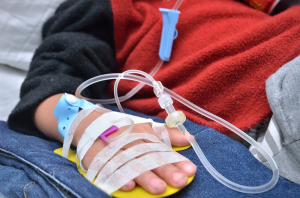Mucormycosis is a fungal infection that is characterized by irregular shapes of hyphae (thread like structures) that can be caused by a number of rare fungi (species of Rhizomucor, Rhizopus and others). It happens mostly in patients whose immune system is compromised such as in AIDS patients, patients with poorly controlled diabetes in ketoacidosis, with kidney failure or in patients who receive high doses of corticosteroids or other immunosuppressive therapy.
Symptoms
The most common form of mucormycosis is an infection inside the nose that spreads to the sinuses and through the bone into the base of the brain cavity. Associated with this can be excruciating pain deep underneath the face and in the bones of the sinuses. Headaches, fever, and a breakdown of the palate bone on top of the roof of the mouth cavity are some of the possible and more common symptoms. There can be a pussy nasal discharge, swelling around the eye socket with bone destruction of the bones behind and around the eye. Here is a picture of mucormycosis (thanks to www.oerafrica.org for this link). Superinfection with bacteria can lead to more dangerous cellulitis around the eye, which could very quickly will spread into the meningeal membranes, if untreated, and cause meningitis. Occasionally the initial lesions are found in the lungs, the skin or the GI tract.
Diagnosis
The diagnosis of this condition is very difficult and the physician must have a high index of suspicion. The only positive tests are histological examination of tissue biopsy samples by an experienced histopathologist. The characteristic irregularly shaped hyphae are what make the diagnosis. Cultures are not reliable and there is presently no reliable blood test antibody titer.

Mucormycosis (If Intravenous Amphotericin B Is Not Working Alone, Surgery May Be Required In Addition)
Surgery
SurgerySurgery
Treatment
Treatment is also difficult, as the only reliable drug that helps is intravenous amphotericin B, but this will not reach avascular abscessed areas. This means then that affected areas that do not have a lot of blood vessels need to be surgically explored and any infected material should be excised until the vascular margin is reached. The remainder of the disease should then be amenable to the intravenous amphotericin B. Other oral antifungal antibiotics have not been found to be of benefit (Ref. 1, p. 1223 and 1225).
References:
1.The Merck Manual, 7th edition, by M. H. Beer s et al., Whitehouse Station, N.J., 1999. Chapter 158.
2.The Merck Manual, 7th edition, by M. H. Beers et al., Whitehouse Station, N.J., 1999. Chapter 113.
3. The Merck Manual, 7th edition, by M. H. Beers et al., Whitehouse Station, N.J., 1999. Chapter 164.
4.David Heymann, MD, Editor: Control of Communicable Diseases Manual, 18th Edition, 2004, American Public Health Association.






